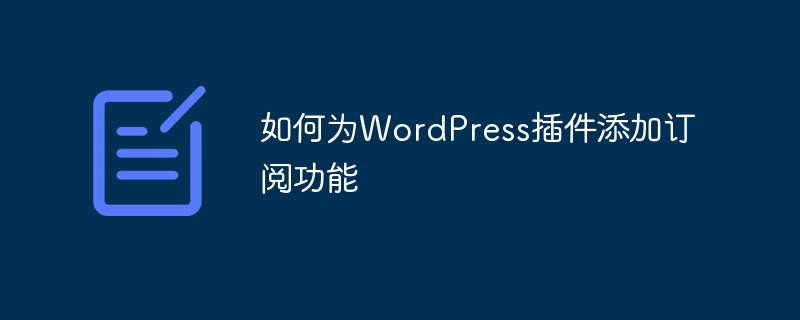Home >CMS Tutorial >WordPress >How to add subscription functionality to WordPress plugin
How to add subscription functionality to WordPress plugin
- PHPzOriginal
- 2023-09-05 09:33:271203browse

How to add subscription function to WordPress plug-in
WordPress is a powerful content management system that is widely used in various types of websites. In order to enhance the interactivity of the website, many websites hope to provide users with a subscription function so that users can obtain the latest content updates in a timely manner. In WordPress, this function can be achieved by developing plug-ins. The following will introduce how to add subscription functionality to WordPress plugins and give specific code examples.
First of all, before developing a plug-in, we need to understand how the subscription function of WordPress is implemented. The subscription function in WordPress mainly notifies users of the release of new content on the website through emails. When a new article or page is published, WordPress will automatically send an email to users who have subscribed to the website. Therefore, we need to add a subscribe button to the plug-in. When the user clicks the button, the user's email address will be saved in the database and the user will be notified when new content is published on the website.
Next, we need to create a new database table to save the user's subscription information. Database tables can be created using the dbDelta function provided by WordPress. Here is an example code snippet:
global $wpdb;
$wpdb->query("CREATE TABLE IF NOT EXISTS {$wpdb->prefix}subscribers (
id INT AUTO_INCREMENT PRIMARY KEY,
email VARCHAR(255) NOT NULL
)");Add the above code snippet to the plugin's main file, it will run when the plugin is activated and create a database table called "subscribers".
Then, we need to add a front-end page to the plug-in for user subscription. This page can be a simple HTML form asking the user to enter their email address. When a user submits a form, we need to save the email address to the database. The following is an example code snippet:
function wpse_subscription_form() {
if (isset($_POST['email']) && !empty($_POST['email'])) {
global $wpdb;
$email = $_POST['email'];
$wpdb->insert("{$wpdb->prefix}subscribers", array(
'email' => $email,
));
echo '订阅成功!';
}
else {
echo '<form action="" method="POST">
<label for="email">请输入您的邮箱地址:</label>
<input type="email" name="email" id="email" required />
<input type="submit" value="订阅" />
</form>';
}
}By adding the above code snippet to the main file of the plug-in, we create a simple front-end page where users can enter their email address to subscribe.
Finally, we need to add a background management page to the plug-in to manage subscribed users. This page lists all subscriber email addresses and provides a delete function. The following is an example code snippet:
function wpse_subscribers_page() {
global $wpdb;
if (isset($_GET['action']) && $_GET['action'] === 'delete') {
$id = $_GET['id'];
$wpdb->delete("{$wpdb->prefix}subscribers", array('id' => $id));
}
$subscribers = $wpdb->get_results("SELECT * FROM {$wpdb->prefix}subscribers");
if (!empty($subscribers)) {
echo '<table>
<tr>
<th>ID</th>
<th>Email</th>
<th>操作</th>
</tr>';
foreach ($subscribers as $subscriber) {
echo '<tr>
<td>' . $subscriber->id . '</td>
<td>' . $subscriber->email . '</td>
<td><a href="?page=subscribers&action=delete&id=' . $subscriber->id . '">删除</a></td>
</tr>';
}
echo '</table>';
}
else {
echo '没有订阅用户!';
}
}By adding the above code snippet to the main file of the plug-in, we create a background management page that can manage subscribed users.
Through the above code examples and introduction, we can add the subscription function to the WordPress plug-in and manage subscriber users through a front-end page and a back-end management page. This way our plugin is more interactive and user-friendly. Hope this article helps you!
The above is the detailed content of How to add subscription functionality to WordPress plugin. For more information, please follow other related articles on the PHP Chinese website!

